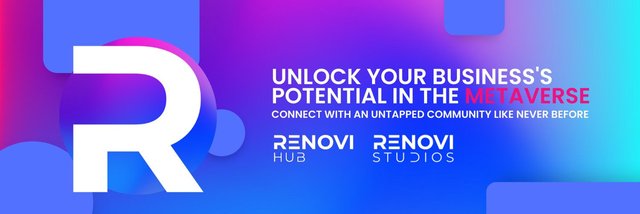Renovi - Unlock Your Potential in the Metaverse with Our Web Design Agency

What is Renovi?
Renovi is a platform that enables architects to produce and distribute distinctive digital assets as NFTs over a blockchain network. These NFTs might depict architectural plans, computer simulations, drawings, or other types of architecture-related creative work.
Architects would be able to mint their digital assets in this market as NFTs, guaranteeing their originality and authenticity. They might then sell these NFTs to collectors who are eager to acquire rare and distinctive architectural-related digital assets.
Similar to other NFT marketplaces, this one would operate by having assets sold using cryptocurrencies and validated on a blockchain network. This would open up a new source of income for architects as well as a new channel for collectors to acquire one-of-a-kind digital works of art.
Additionally, an NFT marketplace for architects would make it possible for architects to engage with new clients and display their work. Architects might establish a name for themselves as producers of distinctive and priceless digital assets by producing and selling NFTs. This might open up new chances for architects to work on commissioned projects or cooperate with other artists.
In conclusion, an NFT marketplace for architects may offer new opportunities for architects to earn money from their labor and add to the digital economy. It
Architects are developing new strategies to engage with clients and promote their work as the world becomes more digital. Using non-fungible tokens (NFTs) to represent distinct digital assets on a blockchain network is one such trend. We'll talk about the possibilities for an NFT marketplace for architects in this blog post, as well as what it might imply for the sector.
What is an NFT?
Let's start by defining what an NFT is. On a blockchain network, an NFT is a particular kind of cryptographic token that stands in for a special asset. NFTs cannot be traded for a value of an equivalent amount, in contrast to fungible tokens like bitcoins. Every NFT is distinct and has a separate value. They are thus a perfect match for unique digital goods like art, music, and in this instance, architecture.
How can architects use NFTs?
Using NFTs, architects can depict their own digital assets, such as 3D models, digital renderings, and other design components. Architects can demonstrate ownership and authenticity of these assets by minting them as NFTs, and they may be able to sell them on an NFT market.
The benefits of an NFT marketplace for architects
The following are some advantages of such a market: Architects would have a platform to display their work and interact with potential clients through an NFT marketplace.
Showcase distinctive work: Architects can put their distinctive digital assets on display in the market to help clients better grasp their design sensibilities and capabilities.
Authenticate ownership: Architects can demonstrate their ownership and authenticity by minting their digital assets as NFTs, giving clients additional assurance about the reliability of their work.
Create new revenue streams: Architects can potentially sell their NFTs on the marketplace, creating a new revenue stream for their business.
Encourage innovation: A marketplace for NFTs might inspire architects to produce more distinctive and cutting-edge digital assets that can be issued as NFTs and sold to customers.
NFT And Metaverse
Unique digital assets known as NFTs (Non-Fungible Tokens) are validated on a blockchain network. They stand for the ownership and reliability of a particular digital asset, such as a piece of music, a video, or other original content. Blockchain networks, which are distributed and decentralized ledgers that guarantee the legitimacy and uniqueness of NFTs, are where they are created and kept.
A new digital economy is being created in the Metaverse, a virtual world where users can interact with one another and digital goods in real-time. Users can engage with and enjoy immersive environments that blend the real world with the virtual one in this virtual world. The blending of physical and virtual reality effectively creates a shared virtual space. The Metaverse and NFTs are connected because NFTs are a.
The ownership and legitimacy of digital experiences, such as those that take place in the Metaverse as virtual concerts, festivals, and other events, can likewise be represented by NFTs. Access to these experiences can be provided through NFTs, which also gives producers a new source of income.
Overall, it is anticipated that as the Metaverse develops and gains in popularity, the interaction between NFTs and it will strengthen. As a result, new NFT marketplaces that concentrate on digital goods that can be used in the Metaverse have emerged, providing producers and collectors with a fresh way to engage in the digital economy.
Conclusion
Architects are developing new strategies to engage with clients and promote their work as the world becomes more digital. An NFT marketplace for architects would offer a space for architects to display their distinctive digital assets and perhaps even develop new sources of income for their firms. Even if there are difficulties to take into account, there are substantial potential benefits that could spur further innovation in the architecture sector.
For more information
- Website: https://www.renovi.io/
- Whitepaper: https://docsend.com/view/vrw3m9krg55jf8ph
- Telegram: https://t.me/RenoviHUB
- Twitter: https://twitter.com/renovihub
- Discord: https://discord.gg/ZKSWQJuBuh
- Instagram: https://instagram.com/renovihub
Username: Bidadari_surga
Forum Profile Link: https://bitcointalk.org/index.php?action=profile;u=1011291
Telegram Username: @Bidadari26
BEP-20 Wallet Address: 0x0c1Ea583808DD14aBb072FCb44C1B3daFC1Cc384